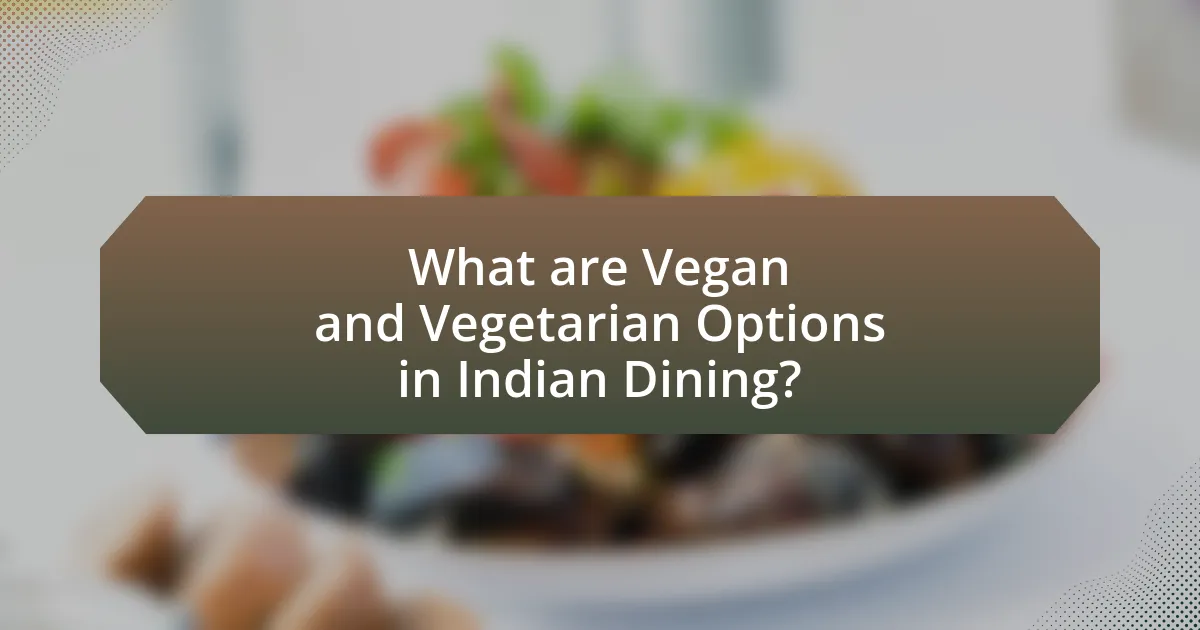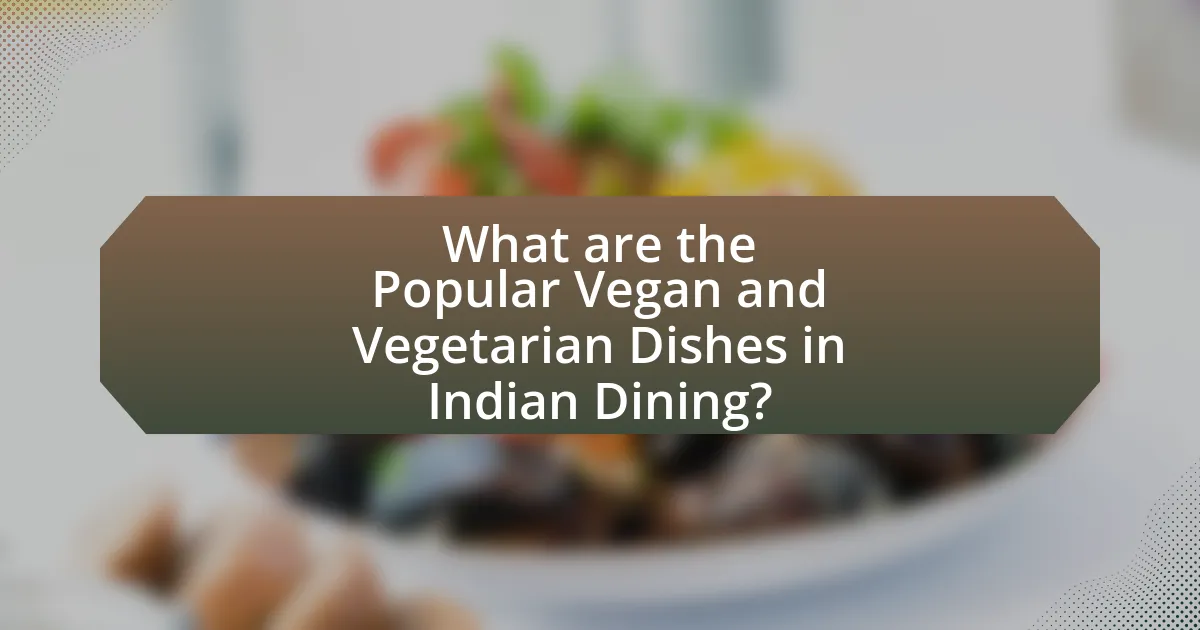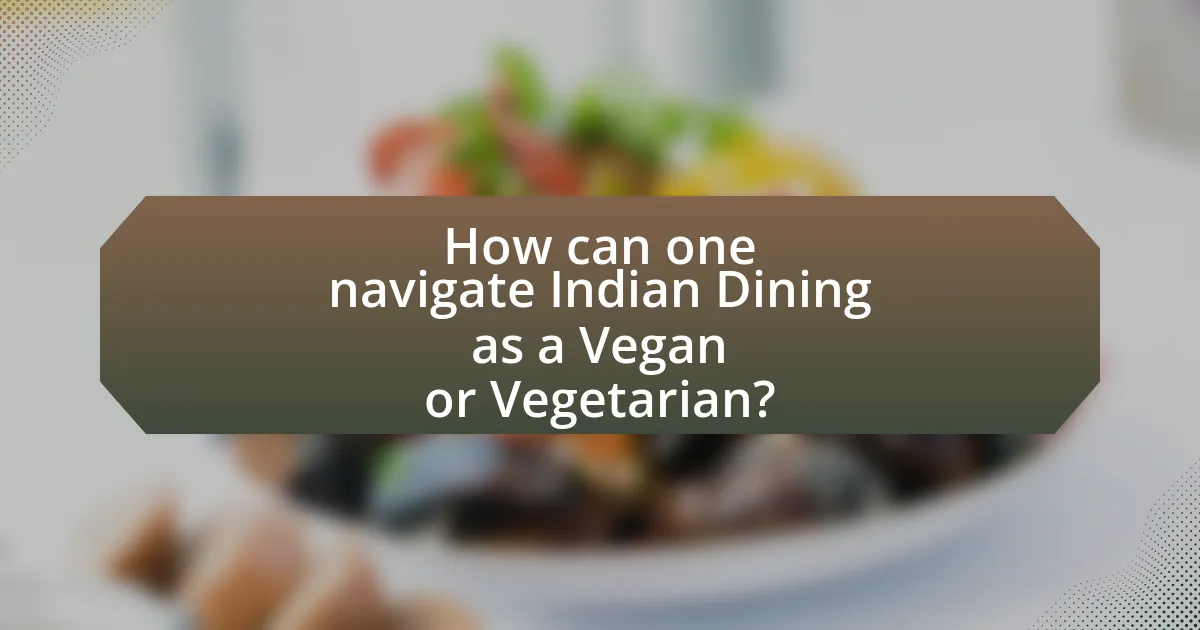The article explores the diverse vegan and vegetarian options available in Indian dining, highlighting the rich array of plant-based dishes that cater to these diets. It details the differences between vegan and vegetarian diets within the context of Indian cuisine, emphasizing the use of legumes, vegetables, and spices. Key ingredients commonly found in vegan and vegetarian dishes are identified, along with popular dishes such as Chana Masala, Aloo Gobi, and Paneer Tikka. The article also discusses cultural influences on plant-based diets in India, misconceptions about vegan and vegetarian food, and practical tips for navigating Indian menus to ensure a satisfying dining experience.

What are Vegan and Vegetarian Options in Indian Dining?
Vegan and vegetarian options in Indian dining include a wide variety of dishes that cater to plant-based diets. Common vegetarian dishes are paneer tikka, dal makhani, and vegetable biryani, while vegan options often consist of chana masala, aloo gobi, and various lentil soups. Indian cuisine is inherently rich in legumes, vegetables, and spices, making it suitable for both vegans and vegetarians. The use of coconut milk in curries and the absence of dairy in certain dishes further enhance the vegan offerings. Additionally, many Indian breads, such as roti and naan (without butter), are also vegan-friendly.
How do Vegan and Vegetarian diets differ in the context of Indian cuisine?
Vegan and vegetarian diets differ primarily in the inclusion of animal products, with vegetarian diets allowing dairy and eggs while vegan diets exclude all animal-derived ingredients. In the context of Indian cuisine, this distinction is significant; vegetarian dishes often feature paneer (Indian cottage cheese), yogurt, and ghee (clarified butter), which are staples in many traditional recipes. Conversely, vegan Indian cuisine relies on plant-based alternatives, utilizing ingredients like coconut milk, tofu, and various legumes to create rich flavors without animal products. This difference is evident in popular dishes: for instance, a vegetarian biryani may include yogurt and paneer, while a vegan version would substitute these with plant-based ingredients, maintaining the essence of the dish while adhering to vegan principles.
What ingredients are commonly used in Vegan Indian dishes?
Common ingredients in Vegan Indian dishes include lentils, chickpeas, various vegetables, spices, and coconut. Lentils, such as masoor and toor dal, serve as a primary protein source, while chickpeas are often used in dishes like chana masala. A wide variety of vegetables, including spinach, cauliflower, and eggplant, are frequently incorporated, providing essential nutrients and flavors. Spices such as turmeric, cumin, coriander, and garam masala are fundamental for seasoning, contributing to the rich taste profile of Indian cuisine. Coconut, in forms like milk or grated, is also commonly used in southern Indian vegan dishes, enhancing creaminess and flavor. These ingredients collectively form the backbone of many traditional and contemporary vegan Indian recipes.
What ingredients are commonly used in Vegetarian Indian dishes?
Common ingredients used in Vegetarian Indian dishes include lentils, chickpeas, various vegetables, rice, and spices such as cumin, coriander, and turmeric. Lentils, a staple protein source, are often used in dishes like dal. Chickpeas are the base for popular items like chana masala. A wide variety of vegetables, including potatoes, spinach, and cauliflower, are frequently incorporated into curries and stir-fries. Rice serves as a common accompaniment, while spices enhance the flavor profile, with turmeric known for its anti-inflammatory properties and cumin for its digestive benefits. These ingredients reflect the diverse and nutritious nature of vegetarian Indian cuisine.
Why is Indian cuisine particularly suited for Vegan and Vegetarian diets?
Indian cuisine is particularly suited for vegan and vegetarian diets due to its extensive use of plant-based ingredients and a rich variety of dishes that emphasize vegetables, legumes, grains, and spices. The cultural and religious practices in India, such as Hinduism and Jainism, promote vegetarianism, leading to a culinary tradition that naturally incorporates a wide range of meat-free options. For instance, staples like lentils (dal), chickpeas (chana), and a variety of vegetables are commonly used in everyday meals, providing essential nutrients and protein sources for those following vegan or vegetarian diets. Additionally, many traditional Indian dishes, such as curries and stir-fries, can be easily adapted to exclude dairy and meat, further enhancing their suitability for vegan diets.
What cultural factors influence the prevalence of plant-based diets in India?
The prevalence of plant-based diets in India is significantly influenced by cultural factors such as religious beliefs, traditional practices, and social norms. Hinduism, which is the predominant religion in India, promotes ahimsa (non-violence), leading many adherents to adopt vegetarianism as a moral choice. Additionally, various festivals and rituals emphasize plant-based foods, reinforcing their importance in daily life. The cultural significance of vegetarianism is further supported by the historical context, where ancient texts like the Manusmriti advocate for a vegetarian lifestyle. This combination of religious teachings, traditional customs, and societal acceptance contributes to the widespread adoption of plant-based diets across the country.
How does the diversity of Indian cuisine support Vegan and Vegetarian options?
The diversity of Indian cuisine inherently supports vegan and vegetarian options through its extensive use of plant-based ingredients and regional variations. Indian cuisine features a wide array of legumes, vegetables, grains, and spices, allowing for numerous dishes that cater to vegan and vegetarian diets. For instance, staples like lentils (dal), chickpeas (chole), and various vegetables are commonly used in everyday meals across different regions, ensuring that plant-based diets are not only feasible but also flavorful and nutritious. Additionally, many traditional Indian dishes, such as sambar and vegetable curries, are naturally vegan or can be easily adapted to be vegan, reflecting the cultural emphasis on vegetarianism in many Indian communities. This adaptability and variety make Indian cuisine a rich source of vegan and vegetarian options.

What are the Popular Vegan and Vegetarian Dishes in Indian Dining?
Popular vegan and vegetarian dishes in Indian dining include Chana Masala, Palak Paneer, Aloo Gobi, and Daal Tadka. Chana Masala, made from chickpeas, is rich in protein and widely consumed across India. Palak Paneer features spinach and cottage cheese, providing essential nutrients. Aloo Gobi, a dish of potatoes and cauliflower, is known for its flavor and simplicity. Daal Tadka, a lentil dish, is a staple in many households, offering a good source of protein and fiber. These dishes reflect the diverse culinary traditions of India and cater to both vegan and vegetarian diets.
Which Vegan dishes are must-try in Indian cuisine?
Must-try vegan dishes in Indian cuisine include Chana Masala, Aloo Gobi, and Baingan Bharta. Chana Masala, made from chickpeas, is rich in protein and flavored with spices like cumin and coriander. Aloo Gobi, a dish of potatoes and cauliflower, is seasoned with turmeric and garam masala, providing a hearty option. Baingan Bharta, roasted eggplant mashed with spices, offers a smoky flavor profile. These dishes are staples in Indian households and are widely recognized for their taste and nutritional value, making them essential for anyone exploring vegan options in Indian dining.
What are the key ingredients in popular Vegan dishes like Chana Masala?
The key ingredients in popular vegan dishes like Chana Masala include chickpeas, tomatoes, onions, garlic, ginger, and a blend of spices such as cumin, coriander, turmeric, and garam masala. Chickpeas serve as the primary protein source, while tomatoes and onions provide the base for the sauce, contributing to the dish’s flavor and texture. Garlic and ginger enhance the aromatic profile, and the spices are essential for achieving the characteristic taste of Chana Masala. This dish is widely recognized in Indian cuisine for its rich flavors and nutritional benefits, making it a staple in vegan dining options.
How is Vegan Biryani prepared differently from traditional Biryani?
Vegan Biryani is prepared differently from traditional Biryani primarily by omitting meat and using plant-based ingredients instead. In traditional Biryani, marinated meat is layered with rice and cooked together, while Vegan Biryani substitutes meat with vegetables, legumes, or tofu, often incorporating spices and herbs to enhance flavor. This shift not only caters to dietary preferences but also aligns with vegan principles, which avoid animal products. The cooking method remains similar, typically involving layering and slow cooking, but the absence of meat alters the flavor profile and nutritional content, making it suitable for those following a vegan diet.
What are the most beloved Vegetarian dishes in Indian dining?
The most beloved vegetarian dishes in Indian dining include Paneer Tikka, Chole Bhature, Biryani, and Daal Makhani. Paneer Tikka, a marinated and grilled cottage cheese dish, is popular for its smoky flavor and is often served as an appetizer. Chole Bhature, a combination of spicy chickpeas and deep-fried bread, is a staple in North Indian cuisine, celebrated for its rich taste and hearty nature. Biryani, particularly vegetarian versions, is renowned for its aromatic rice layered with vegetables and spices, making it a festive favorite. Daal Makhani, a creamy lentil dish, is cherished for its rich texture and flavor, often served with naan or rice. These dishes reflect the diversity and richness of vegetarian options in Indian cuisine, appealing to a wide range of palates.
What makes Paneer Tikka a favorite among Vegetarian options?
Paneer Tikka is a favorite among vegetarian options due to its rich flavor and satisfying texture. The dish features marinated paneer, which is a high-protein dairy product, grilled to perfection, enhancing its taste and making it a hearty choice for vegetarians. Additionally, the use of spices like cumin, coriander, and garam masala in the marinade not only adds depth of flavor but also appeals to those seeking a robust culinary experience. The combination of protein, flavor, and the grilling process creates a dish that is both nutritious and enjoyable, solidifying its popularity in vegetarian dining.
How is Dal Makhani traditionally prepared and served?
Dal Makhani is traditionally prepared by slow-cooking black lentils and kidney beans in a rich, creamy sauce made from tomatoes, butter, and cream. The lentils are soaked overnight, then boiled until soft, and combined with sautéed onions, garlic, and spices such as cumin and garam masala. This mixture is simmered for several hours to enhance the flavors, often finished with a dollop of butter and cream for richness.
Dal Makhani is typically served hot with naan or rice, garnished with fresh coriander and sometimes accompanied by pickles or yogurt. This dish is a staple in North Indian cuisine and is often featured in festive meals and gatherings, highlighting its cultural significance in vegetarian dining.

How can one navigate Indian Dining as a Vegan or Vegetarian?
To navigate Indian dining as a vegan or vegetarian, one should focus on identifying plant-based dishes and communicating dietary preferences clearly. Indian cuisine offers a variety of vegetarian options, such as lentil-based dals, vegetable curries, and rice dishes, which are often naturally vegan. Additionally, many Indian restaurants are familiar with vegan and vegetarian diets, making it essential to ask about ingredients and preparation methods to avoid dairy or animal products. For instance, ghee (clarified butter) is commonly used, so requesting dishes to be made without it is advisable. Understanding common vegan-friendly ingredients like chickpeas, potatoes, and various spices can also enhance the dining experience.
What tips can help Vegans and Vegetarians choose the right dishes in Indian restaurants?
Vegans and vegetarians can choose the right dishes in Indian restaurants by focusing on specific ingredients and preparation methods. First, they should look for dishes that are explicitly labeled as vegan or vegetarian on the menu, as this indicates that no animal products are used. Common vegan-friendly options include chana masala (chickpea curry), aloo gobi (potato and cauliflower), and various lentil dishes like dal.
Additionally, vegans should inquire about the use of ghee (clarified butter) and cream, which are often included in traditional recipes. Many Indian restaurants are willing to modify dishes upon request, so asking for substitutions can help ensure a meal aligns with dietary preferences.
Furthermore, opting for dishes that feature fresh vegetables, legumes, and whole grains can provide a nutritious and satisfying meal. Familiarizing oneself with common Indian spices and cooking techniques can also enhance the dining experience, as many flavorful dishes are naturally plant-based.
How can one identify Vegan and Vegetarian options on a menu?
To identify vegan and vegetarian options on a menu, look for specific labels or symbols indicating these dietary choices. Many restaurants use clear designations such as “V” for vegetarian and “VG” or “vegan” for vegan dishes. Additionally, ingredients listed in the menu can provide insight; vegetarian options typically exclude meat, fish, and poultry, while vegan options avoid all animal products, including dairy and eggs. In Indian dining, common vegetarian dishes include paneer-based items and lentil curries, while vegan options may feature vegetable curries and dishes made with coconut milk. Understanding these indicators helps diners make informed choices aligned with their dietary preferences.
What questions should one ask the restaurant staff regarding ingredients?
One should ask the restaurant staff about the specific ingredients used in dishes to ensure they align with vegan or vegetarian dietary preferences. Key questions include: “Are any animal products used in this dish?” to clarify the presence of ingredients like dairy or eggs; “What oils are used for cooking?” to identify if animal fats are involved; and “Can you provide information on the sourcing of your vegetables and grains?” to ensure they are free from cross-contamination with non-vegetarian items. These inquiries help diners make informed choices and adhere to their dietary restrictions.
What are some common misconceptions about Vegan and Vegetarian Indian food?
Common misconceptions about vegan and vegetarian Indian food include the belief that it lacks variety and flavor. In reality, Indian cuisine offers a rich diversity of dishes that utilize a wide range of spices, vegetables, and legumes, making it both flavorful and varied. Another misconception is that vegetarian Indian food is primarily limited to lentils and rice; however, it encompasses a vast array of options, including regional specialties like paneer dishes, vegetable curries, and innovative vegan alternatives. Additionally, some people assume that vegan Indian food is difficult to find, but many Indian restaurants now offer dedicated vegan menus, reflecting the growing demand for plant-based options.
Why do some people believe Vegan Indian food lacks flavor?
Some people believe Vegan Indian food lacks flavor due to misconceptions about plant-based diets and a lack of familiarity with the diverse spices used in Indian cuisine. This perception often arises from the assumption that without meat, dishes cannot be rich or satisfying. However, Indian cooking traditionally incorporates a wide array of spices such as cumin, coriander, turmeric, and garam masala, which enhance flavor significantly. Studies show that the use of spices in Indian cooking not only adds depth but also provides health benefits, contradicting the notion that vegan options are bland.
How can one debunk myths about the nutritional value of Vegan and Vegetarian diets?
To debunk myths about the nutritional value of Vegan and Vegetarian diets, one can present scientific evidence demonstrating that these diets can provide all essential nutrients. Research published in the Journal of the American Dietetic Association indicates that well-planned vegan and vegetarian diets are nutritionally adequate and can offer health benefits, including lower risks of heart disease, hypertension, and type 2 diabetes. Additionally, the Academy of Nutrition and Dietetics states that plant-based diets can meet protein needs through legumes, nuts, seeds, and whole grains, countering the myth that these diets lack sufficient protein. By citing credible studies and expert opinions, individuals can effectively challenge misconceptions surrounding the nutritional adequacy of Vegan and Vegetarian diets.
What are the best practices for enjoying Vegan and Vegetarian Indian dining experiences?
To enjoy Vegan and Vegetarian Indian dining experiences, it is essential to explore a variety of dishes that highlight the rich flavors and ingredients of Indian cuisine. Engaging with local restaurants that specialize in vegetarian or vegan options ensures authenticity and quality. For instance, dishes like chana masala, palak paneer (with vegan alternatives), and various lentil preparations showcase the diversity of plant-based ingredients. Additionally, asking for recommendations from staff can lead to discovering regional specialties that may not be widely known. Research indicates that Indian cuisine offers over 200 vegetarian dishes, making it one of the most diverse culinary traditions for plant-based dining.
